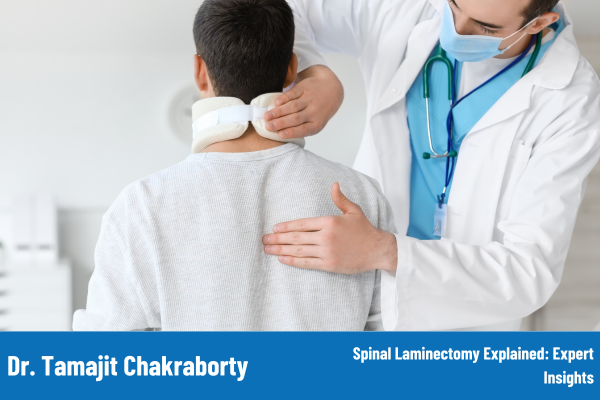Spinal laminectomy is a surgical procedure designed to relieve pressure on the spinal cord or nerves by removing part of the vertebral bone known as the lamina. This procedure is often recommended for individuals suffering from conditions such as spinal stenosis, herniated discs, or degenerative disc disease. Dr. Tamajit Chakraborty, one of the best neurosurgeons specializing in brain and spine surgery in South Kolkata, provides a comprehensive overview of spinal laminectomy, including its benefits, procedure, and recovery.
What is Spinal Laminectomy?
Spinal laminectomy involves the removal of the lamina, which is the bony arch that forms the back of the vertebrae. By removing this portion of the vertebra, the procedure aims to create more space for the spinal cord and nerves, alleviating symptoms caused by compression. The surgery is commonly performed to treat conditions that narrow the spinal canal (spinal stenosis) or to address nerve compression due to herniated discs or bone spurs.
Conditions Treated by Spinal Laminectomy
Dr. Tamajit Chakraborty explains that spinal laminectomy is typically used to treat:
- Spinal Stenosis: Narrowing of the spinal canal that compresses the spinal cord and nerves, often causing pain, numbness, or weakness in the legs and lower back.
- Herniated Discs: When the inner gel-like material of a disc protrudes and presses on nearby nerves, causing pain, tingling, or weakness.
- Degenerative Disc Disease: Wear and tear of the spinal discs that can lead to bone spurs and nerve compression.
- Spinal Tumors: Removing tumors that cause spinal cord or nerve compression.
The Spinal Laminectomy Procedure
The spinal laminectomy procedure is typically performed under general anesthesia and involves several key steps:
- Preparation: The patient is positioned on the operating table, and the surgical site is cleaned and prepared.
- Incision: A small incision is made along the back to access the spine.
- Lamina Removal: The surgeon carefully removes the lamina to relieve pressure on the spinal cord or nerves. In some cases, additional procedures, such as removing herniated disc material or decompressing nerve roots, may be performed.
- Closure: The incision is closed with sutures or staples, and a bandage is applied.
Recovery and Rehabilitation
Post-surgery recovery is a crucial aspect of spinal laminectomy. Dr. Chakraborty highlights the following points regarding recovery:
- Hospital Stay: Patients typically stay in the hospital for a few days after surgery, depending on the complexity of the procedure and individual recovery.
- Pain Management: Pain and discomfort are common after surgery but can be managed with prescribed medications.
- Physical Therapy: Rehabilitation through physical therapy is often recommended to help patients regain strength, flexibility, and mobility. Physical therapy can also aid in preventing future spinal problems.
- Activity Restrictions: Patients are advised to avoid heavy lifting and strenuous activities during the initial recovery period to allow for proper healing.
- Follow-Up Care: Regular follow-up appointments with Dr. Chakraborty are essential to monitor the healing process and ensure that the spine is recovering well.
Benefits of Spinal Laminectomy
Spinal laminectomy can offer significant benefits, including:
- Pain Relief: Many patients experience a reduction in pain and discomfort associated with nerve compression.
- Improved Mobility: By relieving pressure on the spinal cord and nerves, patients often regain better mobility and function.
- Enhanced Quality of Life: Successful surgery can lead to improved daily activities and overall quality of life.
Conclusion
Spinal laminectomy is a valuable surgical option for individuals suffering from conditions that compress the spinal cord or nerves. Dr. Tamajit Chakraborty, a leading neurosurgeon in South Kolkata, provides expert care and precise surgical techniques to ensure the best outcomes for his patients. If you are experiencing symptoms related to spinal stenosis, herniated discs, or other spinal conditions, consulting with Dr. Chakraborty can help determine if spinal laminectomy is the right solution for you.
For personalized care and expert treatment, Dr. Tamajit Chakraborty is available to guide you through the process and support you on your path to recovery.
